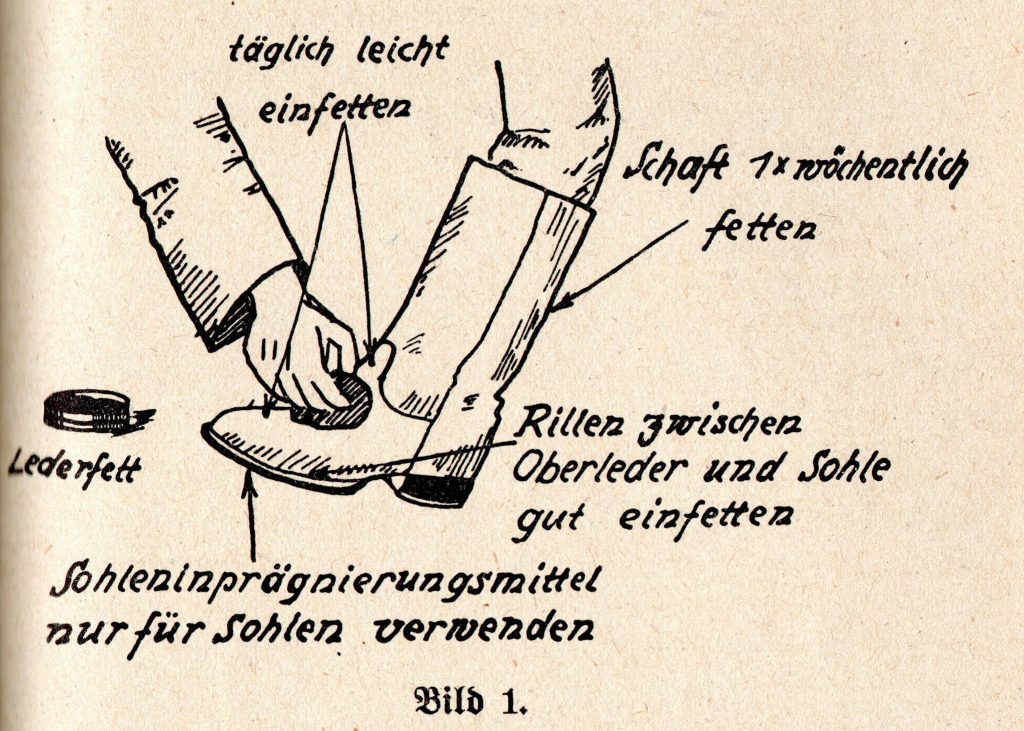
From “Taschenbuch für den Winterkrieg,” 1942
- The troops are to be instructed that well-maintained and well-cared-for footwear in the wet period is important for good health.
Boot inspections are to be conducted as often as possible, as far as the battle situation allows, to check that expert shoe care is being carried out. - Water from melted snow soaks quickly through shoe leather and attacks the leather and particularly the thread at the seams of the footwear. Because leather is not quite waterproof, it needs to be treated in such a way that a level of water resistance can be achieved. For this reason, thorough care of footwear is particularly important during the snow melt. The following guidelines are to be observed.
I. Leather footwear
- Small damages are to be fixed as soon as possible, as damages in leather soaked with snow melt water will soon become bigger.
- Worn-out hobnails should not be removed, because the resulting holes will make the soles water-permeable. Nail new hobnails next to the old ones.
- Soles are not to be worn so much, that the long sole is damaged.
- Wet footwear is to be changed as soon as possible (put on low boots!), wipe out the interior of footwear with rags, stuff with paper, straw or other moisture-absorbent materials. Footwear is to be allowed to gently dry in a slightly warm place only. The wetter the shoe, the greater the danger of making the leather brittle by drying it out quickly in a hot place, by an oven or open fire.
- Clean footwear of dirt daily with brushes or rags. Lightly grease the upper to the ankle level, then vigorously rub in the leather fat with a rag or, even better, with the heel of your hand. Warmed fat soaks better into the leather. But never use too much fat, so that it soaks through the leather and soils your socks and feet. However, you need to generously spread fat into the crease between the upper and the sole, to make this waterproof. (See illustration)
- Once a week thoroughly clean footwear of dirt and any adhered dried leather fat or other shoe care product, by washing it with lukewarm water, allowing it to dry and treating the upper as described above. Greasing the shaft of the boot once a week is sufficient.
- Using leather fat keeps shoe leather soft. Shoe cream alone makes upper leather hard and brittle, and clogs the pores of the leather, trapping the moisture created by the feet inside the boot, promoting frostbite.
- Material for impregnating the soles, as long as it can be delivered, makes the soles waterproof and more durable.
How to use: clean the soles, then apply the substance and let dry. Repeat this process until the sole will not absorb any more of the substance. Do this once or twice per month. This sole impregnation material is only for leather soles, never for rubber soles or upper leather.
II. Rubber boots
- Rubber boots and rubber overboots have to be treated particularly well, in light of the raw material situation. They are not to be worn on road marches.
- Clean with a soft rag and with cold or lukewarm water, never with hot water, oil or gasoline. Don’t use anything sharp to scrape off dirt! To dry, hang somewhere with slight heat, never on or over a stove.
- Fix damaged areas by gluing on rubber patches with rubber cement.
III. Felt boots
- Felt boots can no longer be worn, when the snow becomes watery. Wet felt boots no longer offer any insulation to the feet. The evaporation of the moisture in the felt in the upper part of the boot will strip the feet of their warmth many times, which can cause frostbite even in mildly cold temperatures.
In consideration of the leather parts and leather or rubber soles, dry felt boots only in a slightly warm place!